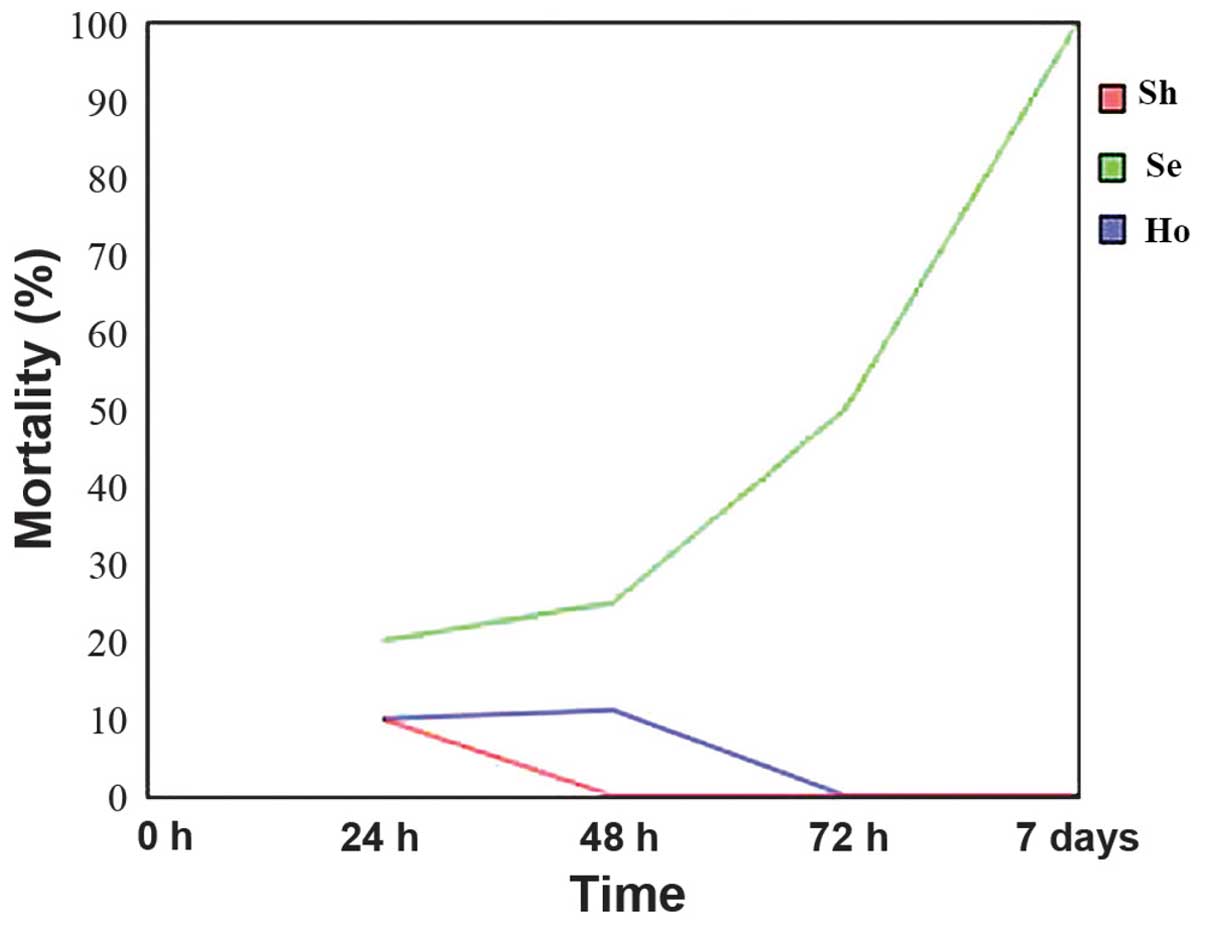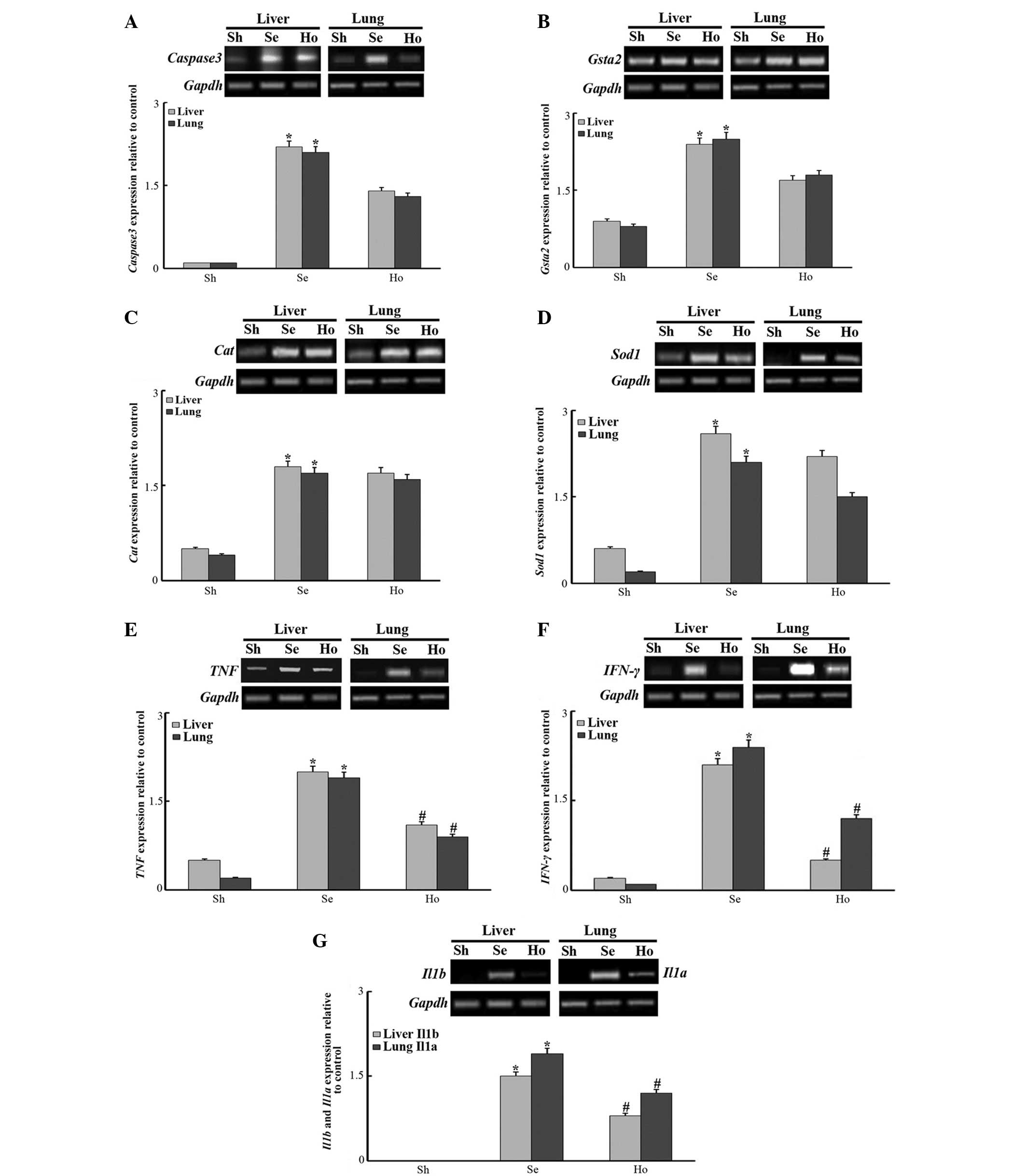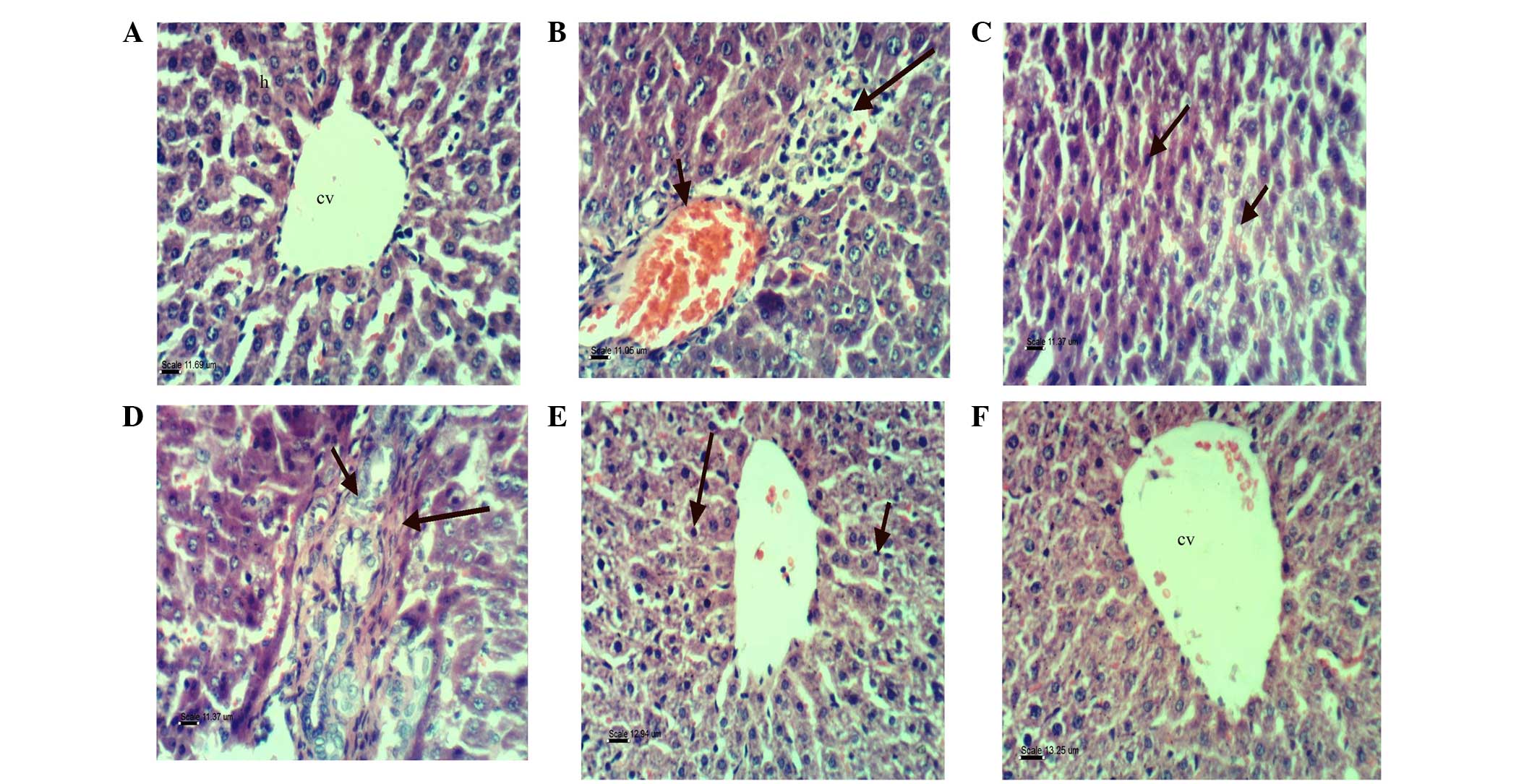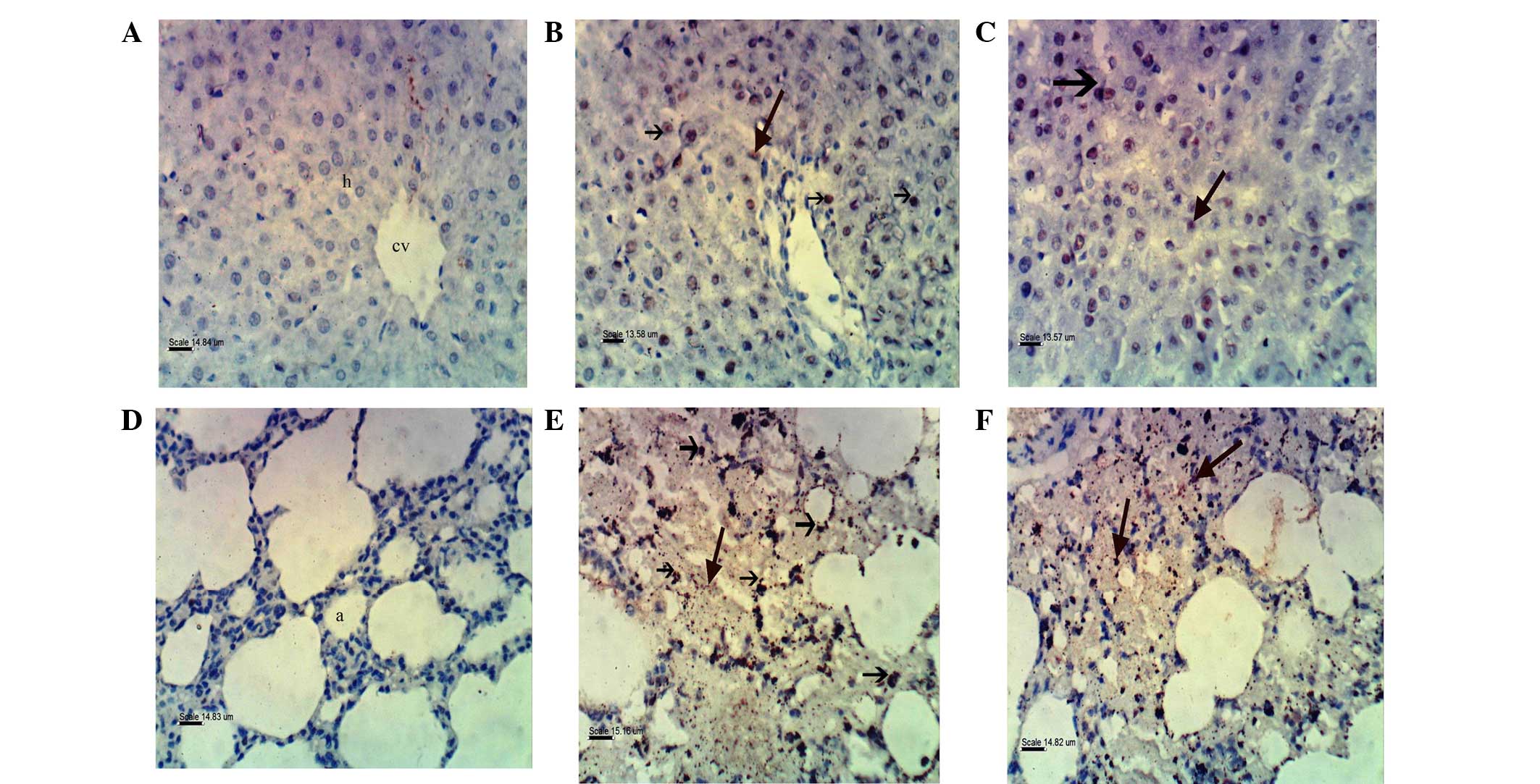|
1
|
Raoofi R, Salmani Z, Moradi F, Sotoodeh A
and Sobhanian S: Procalcitonin as a marker for early diagnosis of
sepsis. Am J Infect Dis. 10:15–20. 2014. View Article : Google Scholar
|
|
2
|
Ma N, Xing C, Xiao H, Wang Y, Wang K, Hou
C, Han G, Chen G, Marrero B, Wang Y, et al: C5a regulates
Il-12+ DC migration to induce pathogenic Th1 and Th17
cells in sepsis. PLoS One. 8:e697792013. View Article : Google Scholar : PubMed/NCBI
|
|
3
|
Galley HF: Oxidative stress and
mitochondrial dysfunction in sepsis. Br J Anaesth. 107:57–64. 2011.
View Article : Google Scholar : PubMed/NCBI
|
|
4
|
Abuşoğlu S, Onur EÇelik Ht, Güvenç Y,
Sakarya M, Sakarya A, Var A and Uyanik BS: The effect of lidocaine
on liver tissue lipid peroxide levels in septic rat model. Int J
Mevlana Med Sci. 1:31–34. 2013.
|
|
5
|
Mansour AA, Salam MA and Saad YM: Mice
(Mus musculus) genome responses to methotrexate (MTX) and
some plant extracts. Life Sci J. 9:4881–4886. 2012.
|
|
6
|
Bergquist M, Nurkkala M, Rylander C,
Kristiansson E, Hedenstierna G and Lindholm C: Expression of the
glucocorticoid receptor is decreased in experimental Staphylococcus
aureus sepsis. J Infect. 67:574–583. 2013. View Article : Google Scholar : PubMed/NCBI
|
|
7
|
Hill AL, Lowes DA, Webster NR, Sheth CC,
Gow NA and Galley HF: Regulation of pentraxin-3 by antioxidants. Br
J Anaesth. 103:833–839. 2009. View Article : Google Scholar : PubMed/NCBI
|
|
8
|
Nesseler N, Launey Y, Aninat C, Morel F,
Mallédant Y and Seguin P: Clinical review: The liver in sepsis.
Crit Care. 16:2352012. View
Article : Google Scholar : PubMed/NCBI
|
|
9
|
Ozturk E, Demirbilek S, Begec Z, Surucu M,
Fadillioglu E, Kirimlioglu H and Ersoy MO: Does leflunomide
attenuate the sepsis-induced acute lung injury? Pediatr Surg Int.
24:899–905. 2008. View Article : Google Scholar : PubMed/NCBI
|
|
10
|
Ates I, Dogan N, Aksoy M, Halıcı Z,
Gündogdu C and Keles MS: The protective effects of IgM-enriched
immunoglobulin and erythropoietin on the lung and small intestine
tissues of rats with induced sepsis: Biochemical and
histopathological evaluation. Pharm Biol. 53:78–84. 2015.
View Article : Google Scholar : PubMed/NCBI
|
|
11
|
Edelman DA, Jiang Y, Tyburski JG, Wilson
RF and Steffes CP: Cytokine production in
lipopolysaccharide-exposed rat lung pericytes. J Trauma. 62:89–93.
2007. View Article : Google Scholar : PubMed/NCBI
|
|
12
|
Spooner CE, Markowitz NP and Saravolatz
LD: The role of tumor necrosis factor in sepsis. Clin Immunol
Immunopathol. 62:S11–S17. 1992. View Article : Google Scholar : PubMed/NCBI
|
|
13
|
Suk K, Chang I, Kim YH, Kim S, Kim JY, Kim
H and Lee MS: Interferon gamma (IFNgamma) and tumor necrosis factor
alpha synergism in ME-180 cervical cancer cell apoptosis and
necrosis. IFNgamma inhibits cytoprotective NF-kappa B through
STAT1/IRF-1 pathways. J Biol Chem. 276:13153–13159. 2001.
View Article : Google Scholar : PubMed/NCBI
|
|
14
|
Price G, Brenner MK, Prentice HG,
Hoffbrand AV and Newland AC: Cytotoxic effects of tumour necrosis
factor and gamma-interferon on acute myeloid leukaemia blasts. Br J
Cancer. 55:287–290. 1987. View Article : Google Scholar : PubMed/NCBI
|
|
15
|
Pasparakis M, Alexopoulou L, Episkopou V
and Kollias G: Immune and inflammatory responses in TNF
alpha-deficient mice: A critical requirement for TNF alpha in the
formation of primary B cell follicles, follicular dendritic cell
networks and germinal centers and in the maturation of the humoral
immune response. J Exp Med. 184:1397–1411. 1996. View Article : Google Scholar : PubMed/NCBI
|
|
16
|
Rothe J, Lesslauer W, Lötscher H, Lang Y,
Koebel P, Althage A, Zinkernagel R, Steinmetz M, Bluethmann H and
Köntgen F: Mice lacking the tumour necrosis factor receptor 1 are
resistant to TNF-mediated toxicity but highly susceptible to
infection by Listeria monocytogenes. Nature. 364:798–802. 1993.
View Article : Google Scholar : PubMed/NCBI
|
|
17
|
Lv S, Han M, Yi R, Kwon S, Dai C and Wang
R: Anti-TNF-α therapy for patients with sepsis: A systematic
meta-analysis. Int J Clin Pract. 68:520–528. 2014. View Article : Google Scholar : PubMed/NCBI
|
|
18
|
Doherty DE and Worthen GS:
Lipopolysaccharide-induced monocyte retention in the lungs of
rabbits. Role of cell stiffness and the CD11/CD18 leukocyte
adhesion complex. Chest. 105(3 Suppl): 108S1994. View Article : Google Scholar : PubMed/NCBI
|
|
19
|
Silva AT and Cohen J: Role of
interferon-gamma in experimental gram-negative sepsis. J Infect
Dis. 166:331–335. 1992. View Article : Google Scholar : PubMed/NCBI
|
|
20
|
Car BD, Eng VM, Schnyder B, Ozmen L, Huang
S, Gallay P, Heumann D, Aguet M and Ryffel B: Interferon gamma
receptor deficient mice are resistant to endotoxic shock. J Exp
Med. 179:1437–1444. 1994. View Article : Google Scholar : PubMed/NCBI
|
|
21
|
Heinzel FP: The role of IFN-gamma in the
pathology of experimental endotoxemia. J Immunol. 145:2920–2924.
1990.PubMed/NCBI
|
|
22
|
Boehm U, Klamp T, Groot M and Howard JC:
Cellular responses to interferon-gamma. Annu Rev Immunol.
15:749–795. 1997. View Article : Google Scholar : PubMed/NCBI
|
|
23
|
Shtrichman R and Samuel CE: The role of
gamma interferon in antimicrobial immunity. Curr Opin Microbiol.
4:251–259. 2001. View Article : Google Scholar : PubMed/NCBI
|
|
24
|
Heremans H, Van Damme J, Dillen C,
Dijkmans R and Billiau A: Interferon gamma, a mediator of lethal
lipopolysaccharide-induced Shwartzman-like shock reactions in mice.
J Exp Med. 171:1853–1869. 1990. View Article : Google Scholar : PubMed/NCBI
|
|
25
|
Bosisio D, Polentarutti N, Sironi M,
Bernasconi S, Miyake K, Webb GR, Martin MU, Mantovani A and Muzio
M: Stimulation of toll-like receptor 4 expression in human
mononuclear phagocytes by interferon-gamma: A molecular basis for
priming and synergism with bacterial lipopolysaccharide. Blood.
99:3427–3431. 2002. View Article : Google Scholar : PubMed/NCBI
|
|
26
|
Adib-Conquy M and Cavaillon JM: Gamma
interferon and granulocyte/monocyte colony-stimulating factor
prevent endotoxin tolerance in human monocytes by promoting
interleukin-1 receptor-associated kinase expression and its
association to MyD88 and not by modulating TLR4 expression. J Biol
Chem. 277:27927–27934. 2002. View Article : Google Scholar : PubMed/NCBI
|
|
27
|
Ridzwan BH, Kaswandi MA, Azman Y and Fuad
M: Screening for antibacterial agents in three species of sea
cucumbers from coastal areas of Sabah. Gen Pharmacol. 26:1539–1543.
1995. View Article : Google Scholar : PubMed/NCBI
|
|
28
|
Selva Prabhu A, Ananthan G, Mohamed
Hussain HS and Balasubramanian T: Antibacterial activity of
Ascidian phallusia arabica against human clinical isolates.
J Appl Pharmaceutical Sci. 1:143–145. 2011.
|
|
29
|
Sohair F, Mahmoud AA and Mohannad H:
Ameliorative effect of the sea cucumber Holothuria arenicola
extract against gastric ulcer in rats. J Basic Appl Zoology.
72:16–25. 2015. View Article : Google Scholar
|
|
30
|
Dakrory AI, Fahmy SR, Soliman AM, Mohamed
AS and Amer SA: Protective and curative effects of the sea cucumber
Holothuria atra extract against DMBA-induced hepatorenal
diseases in rats. Biomed Res Int. 2015:5636522015. View Article : Google Scholar : PubMed/NCBI
|
|
31
|
Yahyavi M, Afkhami M, Mokhleci A,
Ehsanpour M, Khazaali1 A, Khoshnood R and Jvadi A: Fatty acid in
local sea cucumber species from Persian Gulf (Qeshm island). Ann
Biol Res. 3:3597–3601. 2012.
|
|
32
|
Coopersmith CM, Chang KC, Swanson PE,
Tinsley KW, Stromberg PE, Buchman TG, Karl IE and Hotchkiss RS:
Overexpression of Bcl-2 in the intestinal epithelium improves
survival in septic mice. Crit Care Med. 30:195–201. 2002.
View Article : Google Scholar : PubMed/NCBI
|
|
33
|
Coopersmith CM, Stromberg PE, Dunne WM,
Davis CG, Amiot DM II, Buchman TG, Karl IE and Hotchkiss RS:
Inhibition of intestinal epithelial apoptosis and survival in a
murine model of pneumonia-induced sepsis. JAMA. 287:1716–1721.
2002. View Article : Google Scholar : PubMed/NCBI
|
|
34
|
Oliver L and Vallette FM: The role of
caspases in cell death and differentiation. Drug Resist Updat.
8:163–170. 2005. View Article : Google Scholar : PubMed/NCBI
|
|
35
|
Nishikawa Y, Furukawa A, Shiga I, Muroi Y,
Ishii T, Hongo Y, Takahashi S, Sugawara T, Koshino H and Ohnishi M:
Cytoprotective effects of lysophospholipids from sea cucumber
holothuria atra. PLoS One. 10:e01357012015. View Article : Google Scholar : PubMed/NCBI
|
|
36
|
Nemzek JA, Hugunin KMS and Opp MR:
Modeling sepsis in the laboratory: Merging sound science with
animal well-being. Comp Med. 58:120–128. 2008.PubMed/NCBI
|
|
37
|
Ercan M and Ozdemir S: The contribution to
studies of the effect of β-glucan on plasma viscosity in a rat
sepsis model. Med Sci Disc. 2:148–153. 2015. View Article : Google Scholar
|
|
38
|
Chien WS, Chen YH, Chiang PC, Hsiao HW,
Chuang SM, Lue SI and Hsu C: Suppression of autophagy in rat liver
at late stage of polymicrobial sepsis. Shock. 35:506–511. 2011.
View Article : Google Scholar : PubMed/NCBI
|
|
39
|
Lo S, Yuan SS, Hsu C, Cheng YJ, Chang YF,
Hsueh HW, Lee PH and Hsieh YC: Lc3 over-expression improves
survival and attenuates lung injury through increasing
autophagosomal clearance in septic mice. Ann Surg. 257:352–363.
2013. View Article : Google Scholar : PubMed/NCBI
|
|
40
|
Purcell SW, Samyn Y and Conand C:
Commercially important sea cucumbers of the world. FAO Species
Catalogue for Fishery Purposes No. 6. Food and Agriculture
Organization. Rome: 2012.
|
|
41
|
Adibpour N, Nasr F, Nematpour F, Shakouri
A and Ameri A: Antibacterial and antifungal activity of
Holothuria leucospilota isolated from Persian Gulf and Oman
sea. Jundishapur J Microbiol. 7:e87082014. View Article : Google Scholar : PubMed/NCBI
|
|
42
|
Attia HF, Kandiel MM, Ismail TA, Soliman
MM, Nassan MA and Mansour AA: Immunohistochemical, cellular
localization and expression of inhibin hormone in the buffalo
(Bubalus bubalis) adenohypophysis at different ages. J Vet
Anat. 5:83–104. 2012.
|
|
43
|
Bancroft JD, Cook HC and Turner DR: Manual
of histological techniques and their diagnostic application (2nd).
Churchill Livingstone. London: 1994.
|
|
44
|
Zarnescu O, Brehar FM, Chivu M and Ciurea
AV: Immunohistochemical localization of caspase-3, caspase-9 and
Bax in U87 glioblastoma xenografts. J Mol Histol. 39:561–569. 2008.
View Article : Google Scholar : PubMed/NCBI
|
|
45
|
Toral-Granda V, Lovatelli A and
Vasconcellos M: Sea cucumbers - A global review of fisheries and
trade. FAO Fisheries and Aquaculture Technical Paper 516. Food and
Agriculture Organization. Rome: 2008.
|
|
46
|
Hasan MH: Stock assessment of holothuroid
populations in the Red Sea waters of Saudi Arabia. SPC Beche-de-mer
Information Bulletin 29. Eeckhaut I: Secretariat of the Pacific
Community. (Nouméa). 31–37. 2009.
|
|
47
|
Dhinakaran DI and Lipton AP: Bioactive
compounds from Holothuria atra of Indian ocean. Springerplus.
3:6732014. View Article : Google Scholar : PubMed/NCBI
|
|
48
|
Esmat AY, Said MM, Soliman AA, El-Masry KS
and Badiea EA: Bioactive compounds, antioxidant potential and
hepatoprotective activity of sea cucumber (Holothuria atra) against
thioacetamide intoxication in rats. Nutrition. 29:258–267. 2013.
View Article : Google Scholar : PubMed/NCBI
|
|
49
|
Baiomy A and Saad D: Histopathological and
immunohistochemical studies of antiseptic effect of Sepia
officinalis against induced sepsis in male albino rats
(Rattus norvegicus). World J Med Sci. 12:303–315. 2015.
|
|
50
|
Rahal A, Kumar A, Singh V, Yadav B, Tiwari
R, Chakraborty S and Dhama K: Oxidative stress, prooxidants and
antioxidants: The interplay. Biomed Res Int. 2014:7612642014.
View Article : Google Scholar : PubMed/NCBI
|
|
51
|
March CJ, Mosley B, Larsen A, Cerretti DP,
Braedt G, Price V, Gillis S, Henney CS, Kronheim SR and Grabstein
K: Cloning, sequence and expression of two distinct human
interleukin-1 complementary DNAs. Nature. 315:641–647. 1985.
View Article : Google Scholar : PubMed/NCBI
|
|
52
|
Bankers-Fulbright JL, Kalli KR and Mckean
DJ: Interleukin-1 signal transduction. Life Sci. 59:61–83. 1996.
View Article : Google Scholar : PubMed/NCBI
|
|
53
|
Wang Q, Zhang H, Zhao B and Fei H:
IL-1beta caused pancreatic beta-cells apoptosis is mediated in part
by endoplasmic reticulum stress via the induction of endoplasmic
reticulum Ca2+ release through the c-Jun N-terminal
kinase pathway. Mol Cell Biochem. 324:183–190. 2009. View Article : Google Scholar : PubMed/NCBI
|
|
54
|
Jiao L, Li X, Li T, Jiang P and Zhang L,
Wu M and Zhang L: Characterization and anti-tumor activity of
alkali-extracted polysaccharide from Enteromorpha intestinalis. Int
Immunopharmacol. 9:324–329. 2009. View Article : Google Scholar : PubMed/NCBI
|
|
55
|
Zhong Y, Khan MA and Shahidi F:
Compositional characteristics and antioxidant properties of fresh
and processed sea cucumber (Cucumaria frondosa). J Agric Food Chem.
55:1188–1192. 2007. View Article : Google Scholar : PubMed/NCBI
|
|
56
|
da Silva Gomes EC, Jimenez GC, da Silva
LC, de Sá FB, de Souza KP, Paiva GS and de Souza IA: Evaluation of
antioxidant and antiangiogenic properties of caesalpinia
echinata extracts. J Cancer. 5:143–150. 2014. View Article : Google Scholar
|
|
57
|
Chenghui L, Beiwei Z, Xiuping D and Liguo
C: Study on the separation and antioxidant activity of enzymatic
hydrolysates from sea cucumber. Food Ferment Ind. 33:50–53.
2007.
|
|
58
|
Chen Y, Miao Y, Huang L, Li J, Sun H, Zhao
Y, Yang J and Zhou W: Antioxidant activities of saponins extracted
from Radix trichosanthis: An in vivo and in vitro
evaluation. BMC Complement Altern Med. 14:1–8. 2014. View Article : Google Scholar : PubMed/NCBI
|
|
59
|
Li SP, Zhao KJ, Ji ZN, Song ZH, Dong TT,
Lo CK, Cheung JK, Zhu SQ and Tsim KW: A polysaccharide isolated
from Cordyceps sinensis, a traditional Chinese medicine,
protects PC12 cells against hydrogen peroxide-induced injury. Life
Sci. 73:2503–2513. 2003. View Article : Google Scholar : PubMed/NCBI
|
|
60
|
Althunibat OY, Hashim RB, Taher M, Daud
JM, Ikeda MA and Zali BI: In vitro antioxidant and
antiproliferative activities of three Malaysian sea cucumber
species. Eur J Sci Res. 37:376–387. 2009.
|
|
61
|
Xu Y, Chen J, Yu X, Tao W, Jiang F, Yin Z
and Liu C: Protective effects of chlorogenic acid on acute
hepatotoxicity induced by lipopolysaccharide in mice. Inflamm Res.
59:871–877. 2010. View Article : Google Scholar : PubMed/NCBI
|
|
62
|
Hu TJ, Wei XJ, Zhang X, Cheng FS, Shuai
XH, Zhang L and Kang L: Protective effect of Potentilla
anserine polysaccharide (PAP) on hydrogen peroxide induced
apoptosis in murine splenic lymphocytes. Carbohyd Polym.
79:356–361. 2010. View Article : Google Scholar
|



















